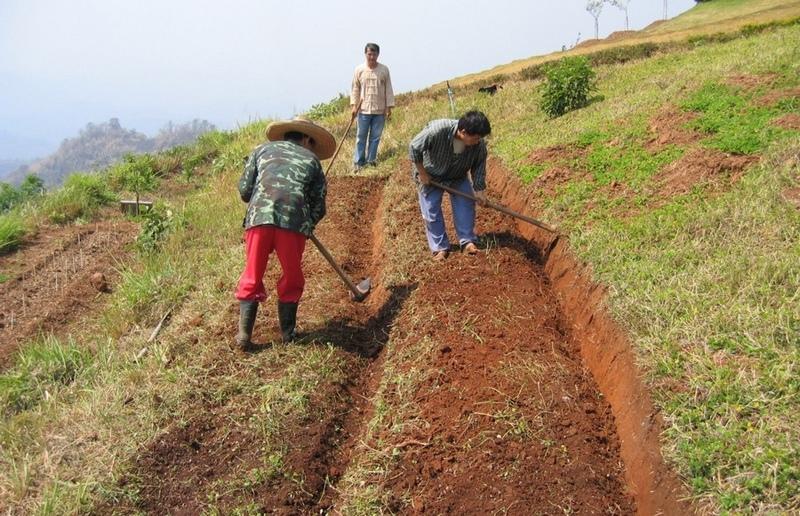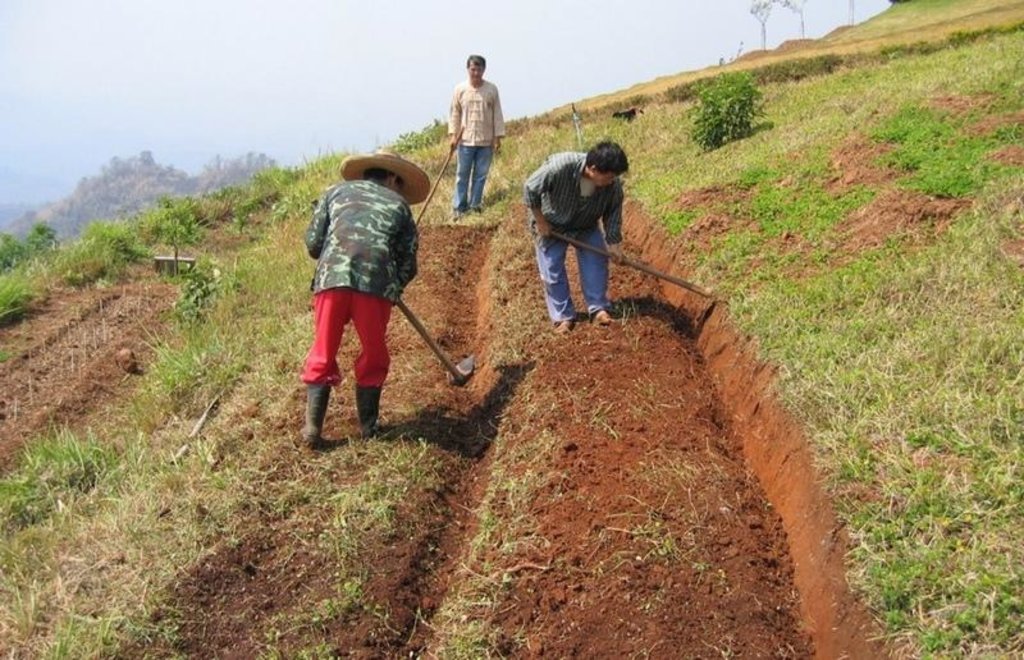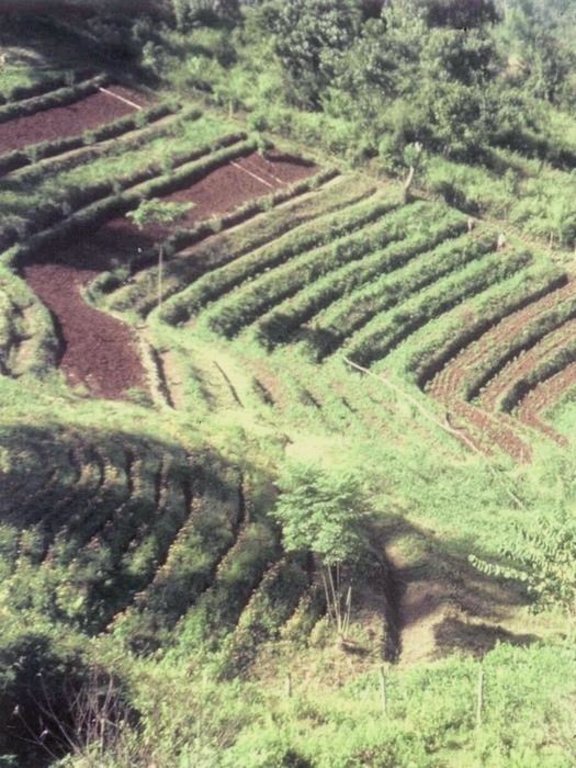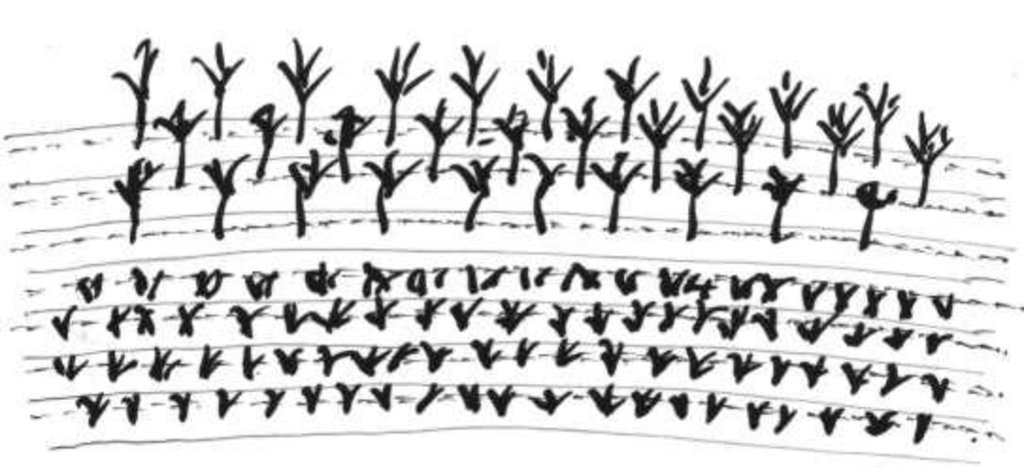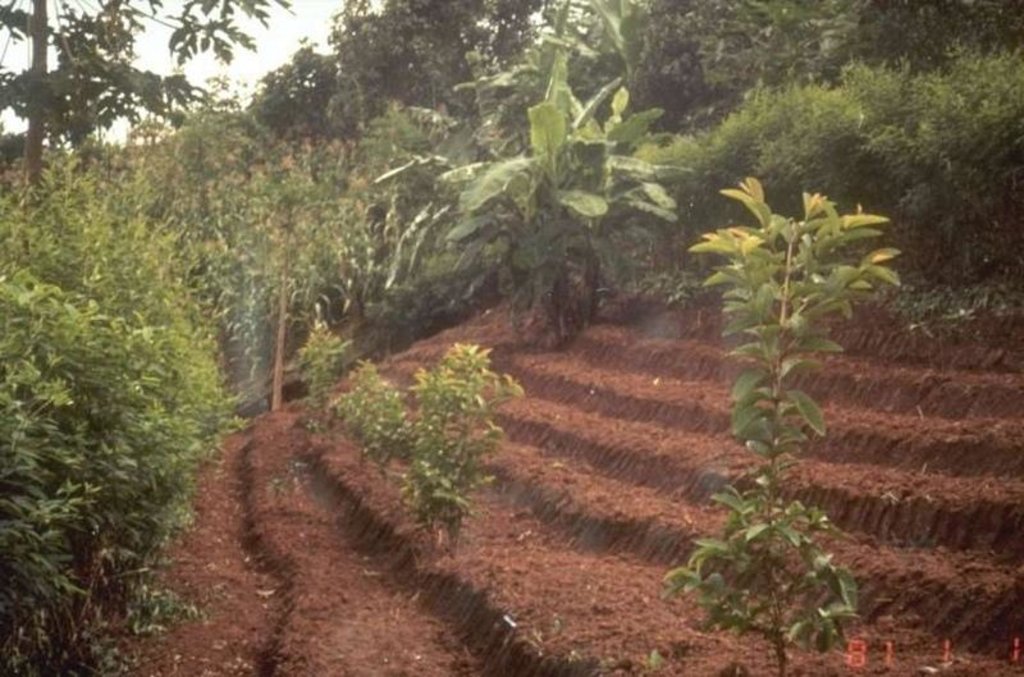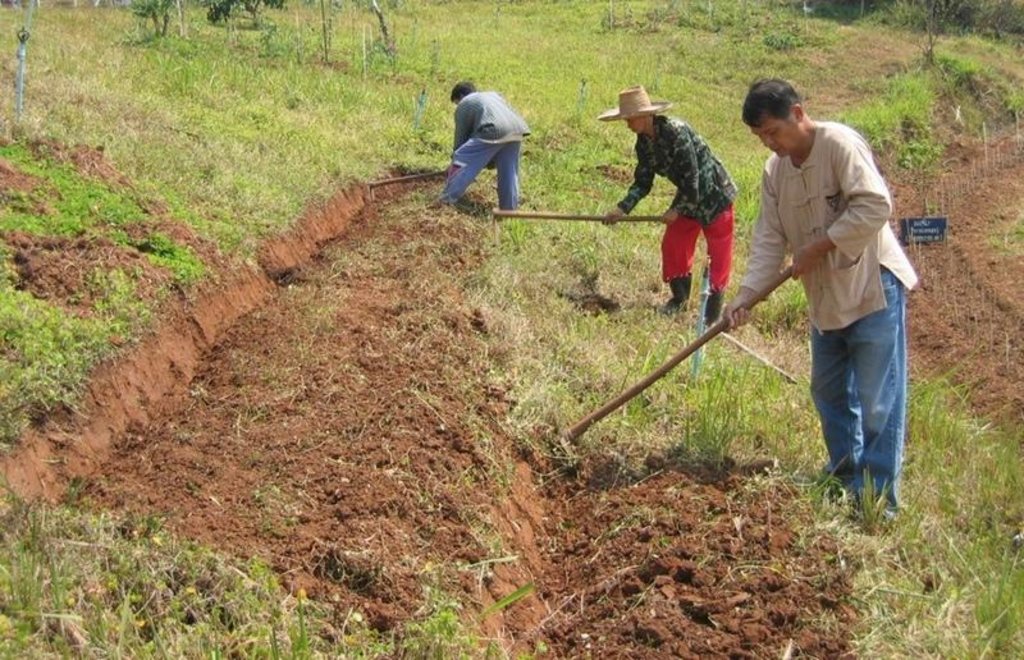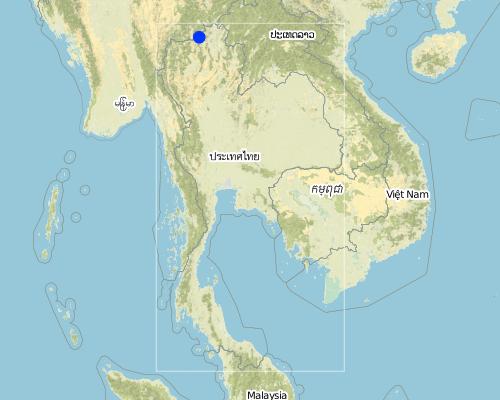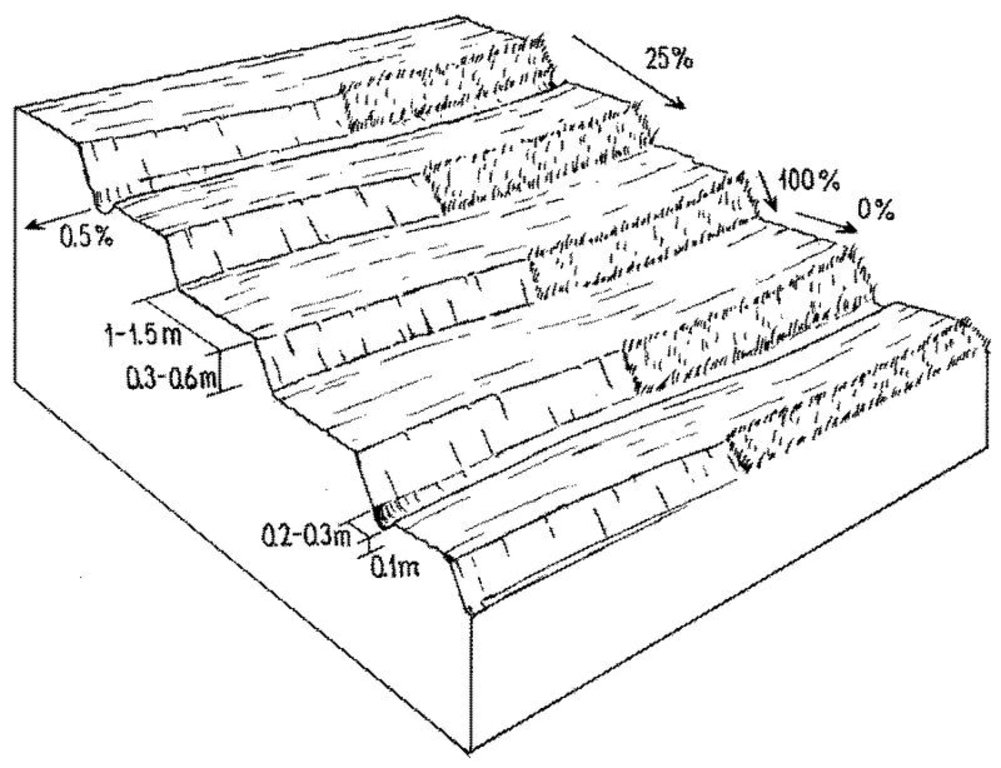Small level bench terraces [تايلاند]
- تاريخ الإنشاء:
- تحديث:
- جامع المعلومات: Samran Sombatpanit
- المحرر: –
- المُراجع: Fabian Ottiger
Khan ban dai din khanard lek (Thai)
technologies_1404 - تايلاند
عرض الأقسام
توسيع الكل طي الكل1. معلومات عامة
1.2 تفاصيل الاتصال بالأشخاص الرئيسيين لمصدر المعلومات والمؤسسات المشاركة في تقييم وتوثيق التقنية
متخصص في الإدارة المستدامة للأراضي:
Cheewinkuntong Wichai
Wang Put Tan, Ban Santikiri, Amphur Mae Fa Luang, Chiang Rai 57110
تايلاند
اسم المشروع الذي سهّل توثيق/تقييم التقنية (إذا كان ذلك على صلة)
Book project: where the land is greener - Case Studies and Analysis of Soil and Water Conservation Initiatives Worldwide (where the land is greener)اسم المؤسسة (المؤسسات) التي سهلت توثيق/تقييم التقنية (إذا كان ذلك على صلة)
World Association of Soil and Water Conservation (WASWC) - الصين1.3 الشروط المتعلقة باستخدام البيانات الموثقة من خلال WOCAT
متى تم تجميع البيانات (ميدانيا)؟:
30/05/2000
يوافق جامع المعلومات والشخص (لاشخاص) الرئيسي لمصدر المعلومات على الشروط المتعلقة باستخدام البيانات الموثقة من خلال WOCAT:
نعم
2. وصف تقنيةالإدارة المستدامي للأراضي
2.1 وصف مختصر للتقنية
تعريف التقنية:
Terraces with narrow beds, used for growing tea, coffee, and horticultural crops on hillsides cleared from forests.
2.2 وصف تفصيلي للتقنية
الوصف:
The terraces described in this case study from northern Thailand are found on hilly slopes with deep soils. The climate is humid and tropical, with 1,700-2,000 mm of rainfall annually. The main aim of the terraces is to facilitate cultivation of tea or coffee on sloping land: erosion control is secondary. Coffee and tea, as well as flowers and vegetables, are good alternatives to opium poppies - which it is government policy to eradicate.
Purpose of the Technology: After clearing natural and secondary forests by slash and burn, terraces are aligned by eye - and constructed by hoe. The width of the bed is 1.0-1.5 m depending on slope, though there are no specific technical guidelines. The length of each terrace can be up to 25 m. Down the slope, after every 3-4 terraces, there are lateral drainage channels, approximately 20-30 cm wide and 10 cm deep. Situated at the foot of a riser, each channel has a gradient of 0.5% or less. Excess water - some of which cascades over the terrace risers, with some draining through the soil - is discharged through these channels, generally to natural waterways. The risers are steep, with a slope of above 100%, and without a defined lip.
Establishment / maintenance activities and inputs: Natural grass cover develops on the risers: this is cut back by hand hoe or machete, or completely removed. The grass is often burned. After harvest (of annual crops), the land is left until immediately before the next rainy season. The terraces at this stage are covered by weeds and grasses. Land is then tilled by hoe. The weeds and grasses are removed and heaped in piles outside the cropped area. They are not composted or used for mulching - and here an opportunity is missed. Where soil fertility is a problem, chemical fertilizers are used. Maintenance includes building up/repairing of risers and levelling of terrace beds as required.
Natural / human environment: The technology was pioneered, and continues to be practiced, by refugee immigrants from China looking for new areas to start farming. These immigrants first came in the 1950s, and cultivated simply through slash and burn techniques. During the 1970s they visited relatives in Taiwan and brought back the idea of small terraces. Originally they settled illegally, but eventually they were given official permission to stay. However, official title deeds to their land have not yet been allocated.
2.3 صور التقنية
2.5 البلد/المنطقة/المواقع التي تم تنفيذ التقنية فيها والتي يغطيها هذا التقييم
البلد:
تايلاند
المنطقة/الولاية/المحافظة:
ChiangMai
مزيد من التفاصيل حول الموقع:
Amphur Mae Fa Luang
Map
×2.6 تاريخ التنفيذ
في حالة عدم معرفة السنة بالتحديد، يرجى الإشارة إلى التاريخ التقريبي:
- منذ أقل من 10 سنوات (مؤخرًا)
2.7 إدخال التقنية
حدد كيف تم إدخال التقنية:
- من خلال ابتكار مستخدمي الأراضي
التعليقات (نوع المشروع، الخ):
Taiwan.
3. تصنيف تقنية الإدارة المستدامي للأراضي
3.1 الغرض الرئيسي ( الأغراض الرئيسية) للتقنية
- تحسين الإنتاج
- الحد من تدهور الأراضي ومنعه وعكسه
- خلق أثر اقتصادي مفيد
3.2 نوع (أنواع) استخدام الأراضي الحالية حيث يتم تطبيق التقنية

الأراضي الزراعية
- زراعة سنوية
- زراعة معمرة (غير خشبية)
المحاصيل الرئيسية (المحاصيل النقدية والغذائية):
Major cash crop annual cropping: Tee, coffee
Major cash crop perennial (non-woody) cropping: Vegetables, flowers
التعليقات:
Major land use problems (compiler’s opinion): - soil erosion on cultivated hillsides
- practical difficulties in tending tea, coffee, vegetables and flowers on sloping land: farming is much easier on levelled land
- Lacking of land ownership (The whole area is reserved forest.)
- Low price of agricultural produce.
Major land use problems (land users’ perception): 1. Lacking of land ownership. 2. Landusers do not have Thai citizenship; less than 20% have ID cards (not citizenship).
Forest: before SWC measures
3.3 مزيد من المعلومات حول استخدام الأراضي
إمدادات المياه للأرض التي يتم تنفيذ التقنية عليها:
- بعلية
عدد مواسم الزراعة في السنة:
- 2
حدد:
Longest growing period in days: 150 Longest growing period from month to month: Dec - Apr
3.4 مجموعةالإدارة المستدامة للأراضي التي تنتمي إليها هذه التقنية
- التدابير المتقاطعة للمنحدرات
- تحويل المياه والصرف
3.5 انتشار التقنية
حدد انتشار التقنية:
- منتشرة بالتساوي على مساحة
إذا كانت التقنية منتشرة بالتساوي على منطقة ما، فحدد المنطقة التقريبية المغطاة:
- 10-1 كم2
التعليقات:
Total area covered by the SLM Technology is 5 km2.
This practice has been done by tribal people such as E-kaw, Lahu, Lisu, Mien, Khin, Thai Yai, Haw Chinese, H'mong
3.6 التدابير التقنية في مجال إلادارة المستدامة للأراضي

التدابير النباتية
- V2: الأعشاب والنباتات العشبية المعمرة

التدابير البنيوية
- S1: المصاطب المتدرجة
التعليقات:
Main measures: structural measures
Secondary measures: vegetative measures
3.7 الأنواع الرئيسية من تدهور الأراضي التي تناولتها التقنية

تآكل التربة بالمياه
- الوزن(Wt): فقدان التربة السطحية/تآكل السطح

التدهور الكيميائي للتربة
- (Cn): تراجع الخصوبة وانخفاض محتوى المادة العضوية (غير ناتج عن الانجراف)

تدهور المياه
- (Ha): التجفيف
التعليقات:
Main type of degradation addressed: Wt: loss of topsoil / surface erosion, Cn: fertility decline and reduced organic matter content, Ha: aridification
Main causes of degradation: deforestation / removal of natural vegetation (incl. forest fires), Lack of enforcement of legislation or authority
Secondary causes of degradation: other human induced causes (specify) (Agricultural activities), other natural causes (avalanches, volcanic eruptions, mud flows, highly susceptible natural resources, extreme topography, etc.) specify
3.8 منع أو حد أو عكس تدهور الأراضي
تحديد هدف التقنية فيما يتعلق بتدهور الأراضي:
- منع تدهور الأراضي
4. المواصفات الفنية، وأنشطة التنفيذ، والمدخلات، والتكاليف
4.1 الرسم الفني للتقنية
4.2 المواصفات الفنية/شروحات الرسم الفني
Layout of small level bench terraces. After every third or fourth terrace a lateral drainage channel is built. Later, protective grass cover is established on the risers (right).
Technical knowledge required for field staff / advisors: moderate
Technical knowledge required for land users: moderate
Main technical functions: control of dispersed runoff: retain / trap, reduction of slope angle, reduction of slope length
Secondary technical functions: control of concentrated runoff: impede / retard, increase of infiltration, increase / maintain water stored in soil
Vegetative measure: grass on risers (optional)
Vegetative material: G : grass
Vegetative measure: Vegetative material: G : grass
Vegetative measure: Vegetative material: G : grass
Vegetative measure: Vegetative material: G : grass
Terrace: bench level
Vertical interval between structures (m): 0.4
Spacing between structures (m): 0.3
Height of bunds/banks/others (m): 0.4
Width of bunds/banks/others (m): 1.5
Length of bunds/banks/others (m): 25
Structural measure: drainage channels
Depth of ditches/pits/dams (m): 0.1
Width of ditches/pits/dams (m): .02 - .3
Construction material (earth): It is the earth dug in situ.
Lateral gradient along the structure: 0%
Vegetation is used for stabilisation of structures.
4.3 معلومات عامة بخصوص حساب المدخلات والتكاليف
عملة أخرى/ عملة وطنية (حدد):
Baht
أشر إلى سعر الصرف من الدولار الأمريكي إلى العملة المحلية (إذا كان ذا صلة): 1 دولار أمريكي =:
37,0
اذكر متوسط تكلفة أجر العمالة المستأجرة في اليوم الواحد:
2.16
4.4 أنشطة التأسيس
| النشاط | نوع التدبير | التوقيت | |
|---|---|---|---|
| 1. | Layout is simply by eye and best judgment. | بنيوية أو هيكلية | |
| 2. | Work begins on the lower part of the slope, and then progresses uphill. | بنيوية أو هيكلية | |
| 3. | Farmers cut into the hillside with hoes and drag the soil down to formthe risers and level the terrace beds. | بنيوية أو هيكلية | |
| 4. | Risers are then stabilised/compacted by hoe. | بنيوية أو هيكلية |
4.5 التكاليف والمدخلات اللازمة للتأسيس
| تحديد المدخلات | الوحدة | الكمية | التكاليف لكل وحدة | إجمالي التكاليف لكل مدخل | % من التكاليف التي يتحملها مستخدمو الأراضي | |
|---|---|---|---|---|---|---|
| العمالة | Labour | ha | 1,0 | 270,0 | 270,0 | 100,0 |
| معدات | Tools | ha | 1,0 | 5,0 | 5,0 | 100,0 |
| إجمالي تكاليف إنشاء التقنية | 275,0 | |||||
التعليقات:
Duration of establishment phase: 12 month(s)
4.6 الصيانة/الأنشطة المتكررة
| النشاط | نوع التدبير | التوقيت/الوتيرة | |
|---|---|---|---|
| 1. | Weeds and grasses are removed and piled outside the cropping area. | نباتية | |
| 2. | Land is prepared through tillage by hoe. | بنيوية أو هيكلية | |
| 3. | Risers are built up/repaired where necessary. | بنيوية أو هيكلية | |
| 4. | Terrace beds may need levelling. | بنيوية أو هيكلية |
4.7 التكاليف والمدخلات اللازمة للصيانة/للأنشطة المتكررة (سنويًا)
| تحديد المدخلات | الوحدة | الكمية | التكاليف لكل وحدة | إجمالي التكاليف لكل مدخل | % من التكاليف التي يتحملها مستخدمو الأراضي | |
|---|---|---|---|---|---|---|
| العمالة | Labour | ha | 1,0 | 45,0 | 45,0 | 100,0 |
| معدات | Tools | ha | 1,0 | 45,0 | 45,0 | 100,0 |
| إجمالي تكاليف صيانة التقنية | 90,0 | |||||
التعليقات:
Clearing of forest is not included in the cost calculations. This calculation is based on a typical slope of approximately 20%, with risers of 0.2 m in height and beds 1.0 m wide. Maintenance costs include basic land preparation (for annual crops) or weeding etc for perennial crops.
4.8 أهم العوامل المؤثرة على التكاليف
قدم وصفا لأهم العوامل التي تؤثر على التكاليف:
The slope factor affects most because it will require longer time to construct.
5. البيئة الطبيعية والبشرية
5.1 المناخ
هطول الأمطار السنوي
- < 250 مم
- 251- 500 ملم
- 501 - 750ملم
- 1,000-751 ملم
- 1,500-1,100 ملم
- 2,000-1,500 ملم
- 3,000-2,001 ملم
- 4,000-3,100 ملم
- > 4000 ملم
المواصفات/التعليقات على هطول الأمطار:
Average 1600-1800 mm
المنطقة المناخية الزراعية
- رطبة
Thermal climate class: tropics
5.2 طوبوغرافيا
متوسط الانحدارات:
- مسطح (0-2%)
- بسيط (3-5%)
- معتدل (6-10%)
- متدحرج (11-15%)
- تلال (16-30%)
- شديدة الانحدار(31-60%)
- فائقة الانحدار (>60%)
التضاريس:
- هضاب/سهول
- أثلام مرتفعة
- المنحدرات الجبلية
- منحدرات التلال
- منحدرات في السفوح
- قاع الوادي
المنطقة الارتفاعية:
- 100-0 متر فوق سطح البحر
- 500-101 متر فوق سطح البحر
- 1,000-501 متر فوق سطح البحر
- 1,500-1,001 متر فوق سطح البحر
- 2,000-1,501 متر فوق سطح البحر
- 2,500-2,100 متر فوق سطح البحر
- 3,000-2,501 متر فوق سطح البحر
- 4,000-3,001 متر فوق سطح البحر
- > 4000 متر فوق سطح البحر
التعليقات والمواصفات الإضافية بشأن التضاريس:
Slopes on average: Also steep (ranked 3)
Soil fertility: Low (ranked 1) and very low (ranked 2)
Soil drainage/infiltration: Medium (ranked 1, good drainage though being cleyey soil) and good (ranked 2)
Soil water storage capacity: Medium and low (both ranked 1)
5.3 التربة
متوسط عمق التربة:
- ضحل جدًا (0-20 سم)
- ضحلة (21-50 سم)
- متوسطة العمق (51-80 سم)
- عميقة (81-120 سم)
- عميقة جدًا (> 120 سم)
قوام التربة (التربة السطحية):
- متوسط ( طميي، سلتي)
المواد العضوية في التربة السطحية:
- منخفضة (<1%)
5.6 خصائص مستخدمي الأراضي الذين يطبقون التقنية
التوجه السوقي لنظام الإنتاج:
- الكفاف (الإمداد الذاتي)
- تجاري/سوق
الدخل من خارج المزرعة:
- 10-50% من جميع الإيرادات
المستوى النسبي للثروة:
- ضعيف
- متوسط
مستوى المكننة:
- عمل يدوي
- الجر الحيواني
اذكر الخصائص الأخرى ذات الصلة لمستخدمي الأراضي:
Population density: < 10 persons/km2
6% of the land users are rich and own 35% of the land.
24% of the land users are average wealthy and own 40% of the land.
60% of the land users are poor and own 20% of the land.
10% of the land users are poor and own 5% of the land.
Off-farm income specification: farmers spend much time as farm labourers on other farms or in food processing factories - and some have jobs at construction sites, for example road building
Level of mechanization: Manual work (ranked 1) and animal traction (ranked 2)
Market orientation: Commercial/market (ranked 1, tea, coffee, vegetable and flower production) and subsistence (ranked 2)
5.7 متوسط مساحة الأرض المملوكة أو المستأجرة من قبل مستخدمي الأراضي الذين يطبقون التقنية
- < 0.5 هكتارا
- 0.5 - 1 هكتار
- 1 -2 هكتار
- 2 - 5 هكتار
- 5 - 15 هكتار
- 15 - 50 هكتار
- 50 - 100هكتار
- 500-100 هكتار
- 1,000-500 هكتار
- 10,000-1,000 هكتار
- > 10,000 هكتار
التعليقات:
Average area of land owned or leased by land users applying the Technology: Also 2-5 ha if farmers may farm at 2-4 plots far apart from each other.
5.8 ملكية الأراضي، وحقوق استخدام الأراضي، وحقوق استخدام المياه
ملكية الارض:
- دولة
حقوق استخدام الأراضي:
- فردي
- illegal (initially) (see Annex T3)
- illegal (initially) (see Annex T3)
6. الآثار والتصريحات الختامية
6.1 الآثار التي أظهرتها التقنية في الموقع
الآثار الاجتماعية والاقتصادية
الإنتاج
إنتاج المحاصيل
التعليقات/ حدد:
Production is not decreased.
منطقة الإنتاج
إدارة الأراضي
الدخل والتكاليف
دخل المزرعة
فروقات اقتصادية
عبء العمل
التعليقات/ حدد:
Ease of cultivation. Can walk and work in the farm easier
آثار اجتماعية واقتصادية أخرى
Input constraints
الآثار الاجتماعية والثقافية
المؤسسات المجتمعية
المؤسسات الوطنية
التخفيف من حدة الصراع
الآثار الايكولوجية
دورة المياه / الجريان السطحي
الجريان السطحي
الكمية قبل الإدارة المستدامة للأراضي:
20
الكمية بعد الإدارة المستدامة للأراضي:
15
التربة
رطوبة التربة
التعليقات/ حدد:
During dry spells due to increased infiltration
غطاء التربة
فقدان التربة
الكمية قبل الإدارة المستدامة للأراضي:
50
الكمية بعد الإدارة المستدامة للأراضي:
10
التعليقات/ حدد:
Soil erosion is reduced
دورة المغذيات/إعادة الشحن
التنوع البيولوجي: الغطاء النباتي، الحيوانات
التنوع النباتي
التنوع الحيواني
تنوع الموائل
6.2 الآثار التي أظهرتها التقنية خارج الموقع
تدفقات مائية موثوقة ومستقرة في موسم الجفاف
الفيضان في اتجاه مجرى النهر
تراكم الطمي باتجاه مصب النهر
تلوث المياه الجوفية/الأنهار
الرواسب المنقولة بواسطة الرياح
6.4 تحليل التكلفة والعائد
كيف يمكن مقارنة العوائد نسبة لتكاليف الإنشاء (من وجهة نظر مستخدمي الأراضي)؟
عوائد قصيرة الأجل:
إيجابي قليلا
عوائد طويلة الأجل:
إيجابي
كيف تتم مقارنة العوائدمع كلفة الصيانة/التكاليف المتكررة (من وجهة نظر مستخدمي الأراضي)؟
عوائد قصيرة الأجل:
إيجابي قليلا
عوائد طويلة الأجل:
إيجابي
6.5 اعتماد التقنية
إذا كان متاحًا، قم بتحديد الكمية (عدد الأسر المعيشية و/أو المساحةالمغطاة):
500
من بين جميع الذين تبنوا التقنية، كم عدد الذين فعلوا ذلك بشكل تلقائي، أي دون تلقي أي حوافز مادية/مدفوعات؟:
- 90-50%
التعليقات:
10% of land user families have adopted the Technology with external material support
50 land user families have adopted the Technology with external material support
Comments on acceptance with external material support: estimates
90% of land user families have adopted the Technology without any external material support
450 land user families have adopted the Technology without any external material support
Comments on spontaneous adoption: estimates
There is a little trend towards spontaneous adoption of the Technology
Comments on adoption trend: There is a little growing spontaneous adoption: for example in the Mae Salong area farmers accept these terraces increasingly, but fruit growers tend to prefer intermittent ‘orchard terraces’ - terraces spaced apart, with 5 m or more of undisturbed land in-between. The benches in this case are backward sloping.
6.7 نقاط القوة / المزايا / الفرص التي توفرها التقنية
| نقاط القوة/ المزايا/ الفرص من وجهة نظر مستخدمي الأراضي |
|---|
| For facilitating picking of tea leaves |
| For using as farm path |
| For increasing soil fertility |
| نقاط القوة/ المزايا/ الفرص من وجهة نظر جامع المعلومات أو غيره من الاشخاص الرئيسيين لمصدر المعلومات |
|---|
|
A relatively cheap method of terracing which makes cultivation easier and provides erosion control How can they be sustained / enhanced? Should be further promoted by extension agencies (in areas where cultivation is officially allowed). Allocation of official title deeds to land will speed up the adoption automatically. |
| For improving/maintaining soil fertility |
|
For increasing the yield of tea leaves How can they be sustained / enhanced? Inspecting the field during/after rain to see how efficient they are in conserving soil and water and repair as needed |
| For using as farm path |
| Compared with normal bench terraces, construction does not bring infertile subsoil to the surface. |
6.8 نقاط ضعف / مساوىء / مخاطر التقنية وسبل التغلب عليها
| نقاط الضعف/ المساوىء/ المخاطر من وجهة نظر مستخدم الأراضي | كيف يمكن التغلب عليها؟ |
|---|---|
| Farmers have to pay for its construction. | The government may be able to help in the future. |
| نقاط الضعف/ المساوىء/ المخاطر من وجهة نظر جامع المعلومات أو غيره من الاشخاص الرئيسيين لمصدر المعلومات | كيف يمكن التغلب عليها؟ |
|---|---|
| Does not lend itself to mechanisation: the terrace beds are narrow and only suited to hand hoeing. | Teach farmers techniques of composting and/or mulching. |
|
In this situation grasses and weeds are merely piled and burned rather than being used to improve soil fertility |
7. المراجع والروابط
7.2 المراجع للمنشورات المتاحة
العنوان، المؤلف، السنة، النظام القياسي الدولي لترقيم الكتب ISBN:
No references
الروابط والوحدات المواضيعية
توسيع الكل طي الكلالروابط
لا يوجد روابط
الوحدات المواضيعية
لا يوجد وحدات مواضيعية


